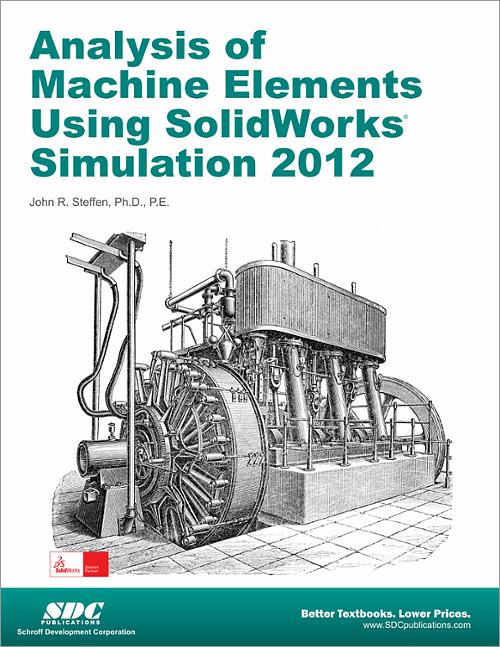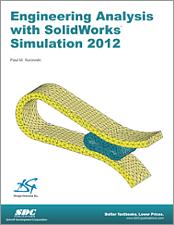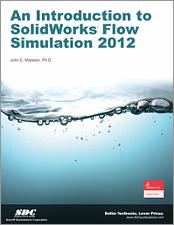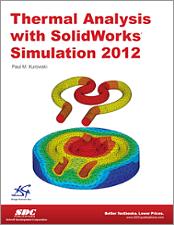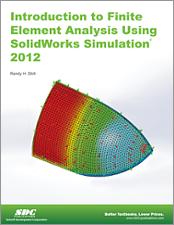Analysis of Machine Elements Using SolidWorks Simulation 2012
- Description
- Contents
- Software
- Downloads
- Details
Description
Key Features
- Designed for first-time SolidWorks Simulation 2012 users
- Focuses on examples commonly found in Design of Machine Elements courses
- Many problems are accompanied by solutions using classical equations
- Combines step-by-step tutorials with detailed explanations of why each step is taken
- Features a new chapter on design optimization
In Detail
Analysis of Machine Elements Using SolidWorks Simulation 2012 is written primarily for first-time SolidWorks Simulation 2012 users who wish to understand finite element analysis capabilities applicable to stress analysis of mechanical elements. The focus of examples is on problems commonly found in an introductory, undergraduate, Design of Machine Elements or similarly named courses.
In order to be compatible with most machine design textbooks, this text begins with problems that can be solved with a basic understanding of mechanics of materials. Problem types quickly migrate to include states of stress found in more specialized situations common to a design of mechanical elements course. Paralleling this progression of problem types, each chapter introduces new software concepts and capabilities.
Many examples are accompanied by problem solutions based on use of classical equations for stress determination. Unlike many step-by-step user guides that only list a succession of steps, which if followed correctly lead to successful solution of a problem, this text attempts to provide insight into why each step is performed.
This approach amplifies two fundamental tenets of this text. The first is that a better understanding of course topics related to stress determination is realized when classical methods and finite element solutions are considered together. The second tenet is that finite element solutions should always be verified by checking, whether by classical stress equations or experimentation.
Each chapter begins with a list of learning objectives related to specific capabilities of the SolidWorks Simulation program introduced in that chapter. Most software capabilities are repeated in subsequent examples so that users gain familiarity with their purpose and are capable of using them in future problems. All end-of-chapter problems are accompanied by evaluation "check sheets" to facilitate grading assignments.
Table of Contents
- Introduction
- Stress Analysis Using SolidWorks Simulation
- Curved Beam Analysis
- Stress Concentration Analysis
- Thin and Thick Wall Pressure Vessels
- Interference Fit Analysis
- Contact Analysis
- Bolted Joint Analysis
- Design Optimization
Appendix A
Appendix B
Index
Software
Up until this year the Student Design Kit (SDK) was included with each SolidWorks textbook from SDC Publications. However, the SDK Program has been terminated by SolidWorks Corporation.
Students will now have access to free copies of SolidWorks through a different mechanism. When a school purchases its SolidWorks license a number of free licenses are available for students. In order to determine how many free licenses are available for students, instructors need to contact SolidWorks directly.
The contact person at SolidWorks is Chris Morse. Her telephone number is (781) 810-5443. Her email address is christine.morse@3ds.com. She will provide software license codes and work with you to make sure that you have enough licenses for every student.
Downloads
The author has provided files for Analysis of Machine Elements using SolidWorks Simulation 2012. They can be downloaded by clicking on the link below.
In addition, the author has provided evaluation forms (see Instructor's Preface, page ix). Use the link below to download these Word files.
For additional information on downloading, unzipping, and using these files visit the downloads section on our FAQ page.
Product Details
| Publisher | SDC Publications |
| Authors | John R. Steffen Ph.D., P.E. |
| Published | June 5, 2012 |
| User Level | Beginner |
| Pages | 390 |
| Binding | Paperback |
| Printing | Black and White |
| Print ISBN | 978-1-58503-705-6 |
| Print ISBN 10 | 1585037052 |
| eBook ISBN | 978-1-63056-095-9 |
